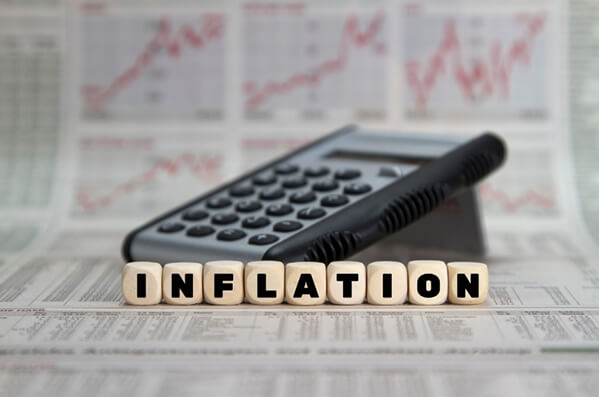What’s Going on With Inflation? 3 Reasons Why It’s Here to Stay
By Jeff Gilbert
Inflation headlines are the norm these days. It didn’t come as a surprise to many that after months of being told the current inflation crisis was transitory, Federal Reserve Chair Jerome Powell announced that we can expect high inflation to continue through 2022. (1) What may have seemed like a slight inconvenience at first is now becoming a much larger issue as prices keep soaring with no clear end in sight.
If you want to know why inflation is up, look no further than the COVID-19 pandemic, which brought the entire global economy to a complete standstill for the only time in modern history. It’s to be expected that the rebound from such a once-in-a-lifetime event will be just as enigmatic as the event itself.
That’s not to say that the future is bleak, but rather to temper expectations so that we can properly plan for the future and mitigate potential risk. Here are some reasons why inflation has increased in the past year and what it means for your long-term purchasing power.
What Is Inflation?
According to Investopedia, inflation is a decrease in the purchasing power of money, reflected in a general increase in the prices of goods and services in an economy. (2) It can be characterized as persistent or transitory. Transitory inflation (3) is temporary and happens when supply doesn’t meet demand. If left unhandled, it can turn into persistent inflation, (4) which results in a more permanent increase in prices due to a continuous mismatch in supply and demand.
The Consumer Price Index (CPI) is a common measure of inflation. The most recent CPI report from December 2021 suggested that inflation has risen an astounding 7% over the past year! (5) That is significantly higher than the typical 2% rise we see in an average year.
Why Is Inflation So High?
To better understand if inflation will last, let’s take a look at the factors contributing to its rise.
Devalued Dollar
When the COVID-19 pandemic first hit and millions of Americans were furloughed or laid off, drastic economic measures were taken to keep the country afloat. The U.S. government instituted expansionary monetary and fiscal policies in order to pump money back into the economy, increasing the money supply at a rapid rate. It jumped from $15.5 trillion in February 2020 to $18.8 trillion in October 2020, an increase of over $3 trillion. (6)
Though experts agree that these drastic measures were necessary to keep the economy from collapsing, they also agree that the increase in money supply devalued the dollar, meaning it takes more dollars to buy the same item since each dollar is less valuable.
This issue is further compounded by the current trade deficit, which is sitting at a $174.6 billion (28.6%) year-to-date increase. (7) Because the U.S. buys (imports) more than it sells (exports), a devalued dollar relative to other countries’ currencies drives the cost of imported goods up even more. It’s tempting to write these issues off as fallout from the pandemic, but the trade deficit is not a new issue. In fact, the U.S. has seen a deficit every year since 1975. (8) This indicates that the rise of inflation is not a new issue either, it’s just been sped up and exacerbated by the increase in government spending in response to the pandemic.
Supply Chain Headaches
If there’s one thing that’s been in the news even more than inflation concerns, it’s supply chain disruptions. Since the vaccine rollouts and slow return to pre-pandemic life, companies have struggled to keep up with manufacturing and distributing goods. This is because many distribution centers cut their hours when the global economy came to a halt in anticipation of a huge drop in demand for consumer goods. The drop in demand, however, did not come.
As people across the globe spent days, then weeks, then months in their houses, demand skyrocketed for exercise equipment, home goods, and office supplies. Factories increased their output, but the distribution chains have struggled to get everything where they need to be.
Additionally, the increased production has also caused a shortage in raw materials, thereby exacerbating the gap between overall supply and demand for even basic items. As demand continues to outpace supply, prices are driven higher and higher.
Labor Shortages and Increasing Wages
Continued labor shortages are another factor driving inflation. In what is being called “The Great Resignation,” millions of workers across America have quit or considered quitting their jobs as they reevaluate the role that work plays in their lives. (9) As such, many companies are finding that they have to pay higher wages in order to attract and retain employees. These increased costs often get passed through to the customer in the form of increased prices for goods and services.
The flip side of the labor shortage issue is the passage of the $15 federal minimum wage. (10) Many states are following suit with plans to increase their respective minimum wage thresholds. So even if companies weren’t paying more for labor because of the struggle to find workers, they would still be paying more due to increasing minimum wage. Again, these increased costs will be passed through to consumers, and it will be more than just a transitory change in prices since the minimum wage laws are permanent.
How Long Will Inflation Last?
It’s tough to say exactly how long inflation will last, but based on these three variables, it could be a couple years before we return to the target rate of 2%. As our global economy shifts, trade alliances change, and we experience the ongoing effects of the COVID-19 pandemic, it seems to be an issue that will persist for the foreseeable future.
Let Us Help You Protect Against Inflation
Even if you’re not worried about degrading purchasing power, skyrocketing inflation is still a headache. It’s another variable to account for when it comes to your long-term financial strategies.
At Balboa Wealth Partners, we have the tools and expertise to guide you through a long-term inflationary environment. We will review your investment and retirement plans for proper diversification and risk tolerance levels, ensuring you are properly protected no matter how long this increased inflation lasts. If you’d like to partner with a financial planner who understands your unique needs and inspires you to be more confident in your financial decisions, give me a call at 949-445-1465 or email me at jgilbert@balboawealth.com.
About Jeff
Jeff Gilbert is the founder and CEO of Balboa Wealth Partners, a holistic financial management firm dedicated to providing clients guidance today for tomorrow’s success. With over three decades of industry experience, he has worked as both an advisor and executive-level manager, partnering with and serving a diverse range of clients. Specializing in serving high- and ultra-high-net-worth families, Jeff aims to help clients achieve their short-term and long-term goals, worry less about their finances, and focus more on their life’s passions. Based in Orange County, Jeff works with clients throughout the entire country. To learn more, connect with Jeff on LinkedIn or email jgilbert@balboawealth.com.
Advisory services provided by Balboa Wealth Partners, Inc., an Investment Advisor registered with the SEC. Advisory services are only offered to clients or prospective clients where Balboa Wealth Partners and its Investment Advisor Representatives are properly licensed or exempt from registration.
Securities offered through Chalice Capital Partners, LLC, member FINRA, SIPC.
Balboa offers advisory services independent of Chalice. Neither firm is affiliated.
______________
(1) https://www.foxbusiness.com/politics/powell-fed-wrong-inflation-not-transitory
(2) https://www.investopedia.com/terms/i/inflation.asp
(3) https://finance.yahoo.com/news/inflation-transitory-persistent-210149448.html
(4) https://finance.yahoo.com/news/inflation-transitory-persistent-210149448.html
(5) https://www.bls.gov/news.release/pdf/cpi.pdf
(6) https://www.statista.com/statistics/1121054/monthly-m2-money-stock-usa/
(7) https://www.census.gov/foreign-trade/Press-Release/current_press_release/ft900.pdf
(8) https://www.thoughtco.com/history-of-the-us-balance-of-trade-1147456




